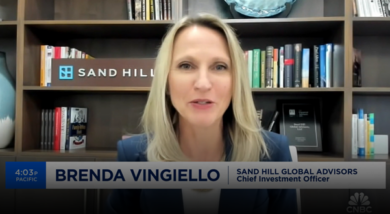Brenda Vingiello, Sand Hill's Chief Investment Officer, joined the Halftime Report to discuss the software space. This content was produced and provided by an unaffiliated

Things Really Are Different This Time
John Templeton, the famous investor and creator of the Templeton Growth Fund, is credited with the popular saying, “The four most dangerous words in the English language are, ‘This time, it’s different.’” He initially used this phrase during a moment of extreme geopolitical uncertainty, but this quote has been referenced countless times over the years when investors have struggled to understand whether financial market circumstances of the moment will ultimately follow a similar historical path or if they will finally result in the one time in history when things are different. Prior to 2020, following Mr. Templeton’s advice generally worked. But this current economic cycle may finally prove him wrong. The number of unprecedented “firsts” that we have experienced over the last few years is enough to cause any economic PhD’s head to spin. We can’t help but think that history may ultimately repeat itself as this cycle wears on, but, for now, we are still in an economic twilight zone.
The emergence of the recent global pandemic was one of the most shocking and life-changing events of our time. The worldwide government response to effectively stop all business activity and send everyone home in response to this public health crisis was monumental and will forever be known as one of the most consequential economic decisions of all time. This was one of the bleakest moments in history as no one could predict what the health impact of the pandemic would be and how long it might last. The world’s aggregate GDP quickly fell by about 3.5%, which was 6% worse than what the International Monetary Fund (IMF) had been projecting for 2020. Fortunately, this adverse impact was relatively short-lived as it was met with considerable financial support for households, firms, and financial markets.
Indeed, given the gravity of the economic shutdown, the United States government spent the equivalent of 12% of GDP on stimulus measures in 2020. This compares to similar types of spending of just 1% of GDP in 2008 and 4% in 2009.1 This level of stimulus was so significant that it caused a phenomenon we had never experienced before—incomes rose even as the unemployment rate moved higher. With everyone stuck at home, Americans did what we have historically been very good at—shopping—only this time, we did it like never before. The sheer volume of purchased goods clogged up supply chains and caused the price of additional goods to rise. Supply shortages became the norm, and ironically this contributed to even more buying. The technology and goods sectors experienced incredible growth during 2020 and 2021, but then slowed considerably when the economy re-opened and consumers abruptly shifted their spending to services and experiences.
This significant change in spending patterns (from goods to services) has contributed to what many are calling a rolling recession, as the best-of-times quickly became the worst-of-times for the technology and goods sectors while services and experiences quickly recovered from their own pandemic-induced recession. What followed was, and continues to be, a period of significant confusion as important economic datapoints have been consistently contradictory for the better part of the last four years. Economic bulls and bears have both been able to point to very plausible, data supported, scenarios for why their projections should come to fruition. As we look to 2024, we expect that spending patterns could finally normalize, and this would be a welcome relief.
Inflation has also continued to be a big and constant source of debate. Pandemic-driven distortions have had a meaningful impact and have made predicting the path of inflation very difficult. Goods inflation was driven by excess demand but that dynamic quickly changed as spending shifted to services, leaving the goods sector with way too much inventory. Prices subsequently came down, providing some proof that this part of the overall inflationary basket was transitory. The cost of labor continues to be relatively high as more baby boomers retire and labor shortages persist. As these higher costs are passed along to end consumers, an inflation rate of 3% may become a more realistic expectation than the 2% that the Federal Reserve is still targeting. However, we still anticipate ongoing improvement in inflation measures as the real-world costs of rent and housing eventually start to be reflected in official government inflation measures such as the Consumer Price Index (CPI).
The most recent head-scratching phenomenon has been the acceleration of economic growth following one of the most aggressive rate-hiking cycles in history. During the third quarter of this year, when short-term interest rates reached 5.5%—a level many felt was likely their peak—GDP growth rose to 4.9%. This outcome was completely outside the realm of normal and is absolutely not in keeping with historical rate-hiking cycles. The growth surprise contributed to longer-term interest rates rising to a 20-year high. Short and long-term interest rates are now much more closely aligned. These higher rates should eventually contribute to economic slowing, but—again, for now—growth appears to be quite steady.
As inflation falls, the real rate of interest will effectively rise, and this should ultimately lead to economic slowing. Other significant areas of the economy such as commercial real estate also face very uncertain futures at this point and any economic impact here could be felt more broadly. However, as we have been reminded of time and again, the pandemic distortions have been significant and may continue to leave economists guessing. We envision this potentially happening if some parts of the economy that have been weak for the last two years begin to normalize, recover, and offset weakness that may develop in other areas.
Our response to this ongoing unpredictable overall environment has been to position portfolios with a cautious tilt. Most of our clients now have more exposure to Treasury bonds than they have had in the last decade. This is primarily due to the more attractive yield that they now offer, but it is also a form of general protection as they should help mitigate volatility in any risk-off market. Geopolitical risk has risen substantially in recent years, first with Ukraine and now with the tragic events that have unfolded in Israel and Gaza. Moreover, if more nations become involved in this latter conflict, there is a greater risk that there could be a global oil supply disruption. This is the type of outcome that is impossible to predict but one where we, once again, think that Treasury bonds will likely provide protection.
As we continue to navigate through the conditions of this unfolding environment, we are hopeful that lingering pandemic distortions will be much less prevalent and consumption trends will be more balanced. Furthermore, the lack of an economic slowdown this year should give corporate management teams more comfort when planning for 2024; although, admittedly, the risk of a recession developing still exists since financial conditions remain quite tight. Finally, we are hopeful for one more “first” for this current economic cycle—a more normalized year in 2024 that actually isn’t different! In the meantime, we will keep at it on your behalf.
1-Commitee for a Responsible Federal Budget, COVID Money Tracker
Articles and Commentary
Information provided in written articles are for informational purposes only and should not be considered investment advice. There is a risk of loss from investments in securities, including the risk of loss of principal. The information contained herein reflects Sand Hill Global Advisors' (“SHGA”) views as of the date of publication. Such views are subject to change at any time without notice due to changes in market or economic conditions and may not necessarily come to pass. SHGA does not provide tax or legal advice. To the extent that any material herein concerns tax or legal matters, such information is not intended to be solely relied upon nor used for the purpose of making tax and/or legal decisions without first seeking independent advice from a tax and/or legal professional. SHGA has obtained the information provided herein from various third party sources believed to be reliable but such information is not guaranteed. Certain links in this site connect to other websites maintained by third parties over whom SHGA has no control. SHGA makes no representations as to the accuracy or any other aspect of information contained in other Web Sites. Any forward looking statements or forecasts are based on assumptions and actual results are expected to vary from any such statements or forecasts. No reliance should be placed on any such statements or forecasts when making any investment decision. SHGA is not responsible for the consequences of any decisions or actions taken as a result of information provided in this presentation and does not warrant or guarantee the accuracy or completeness of this information. No part of this material may be (i) copied, photocopied, or duplicated in any form, by any means, or (ii) redistributed without the prior written consent of SHGA.
Video Presentations
All video presentations discuss certain investment products and/or securities and are being provided for informational purposes only, and should not be considered, and is not, investment, financial planning, tax or legal advice; nor is it a recommendation to buy or sell any securities. Investing in securities involves varying degrees of risk, and there can be no assurance that any specific investment will be profitable or suitable for a particular client’s financial situation or risk tolerance. Past performance is not a guarantee of future returns. Individual performance results will vary. The opinions expressed in the video reflect Sand Hill Global Advisor’s (“SHGA”) or Brenda Vingiello’s (as applicable) views as of the date of the video. Such views are subject to change at any point without notice. Any comments, opinions, or recommendations made by any host or other guest not affiliated with SHGA in this video do not necessarily reflect the views of SHGA, and non-SHGA persons appearing in this video do not fall under the supervisory purview of SHGA. You should not treat any opinion expressed by SHGA or Ms. Vingiello as a specific inducement to make a particular investment or follow a particular strategy, but only as an expression of general opinion. Nothing presented herein is or is intended to constitute investment advice, and no investment decision should be made based solely on any information provided on this video. There is a risk of loss from an investment in securities, including the risk of loss of principal. Neither SHGA nor Ms. Vingiello guarantees any specific outcome or profit. Any forward-looking statements or forecasts contained in the video are based on assumptions and actual results may vary from any such statements or forecasts. SHGA or one of its employees may have a position in the securities discussed and may purchase or sell such securities from time to time. Some of the information in this video has been obtained from third party sources. While SHGA believes such third-party information is reliable, SHGA does not guarantee its accuracy, timeliness or completeness. SHGA encourages you to consult with a professional financial advisor prior to making any investment decision.







